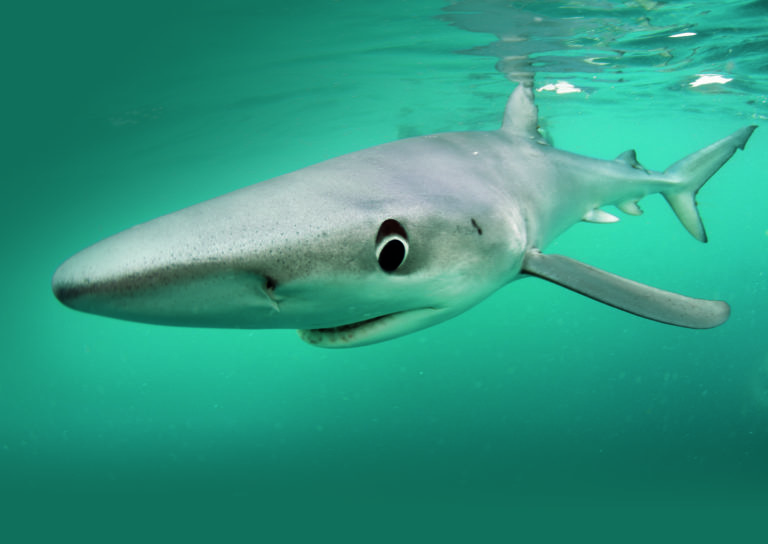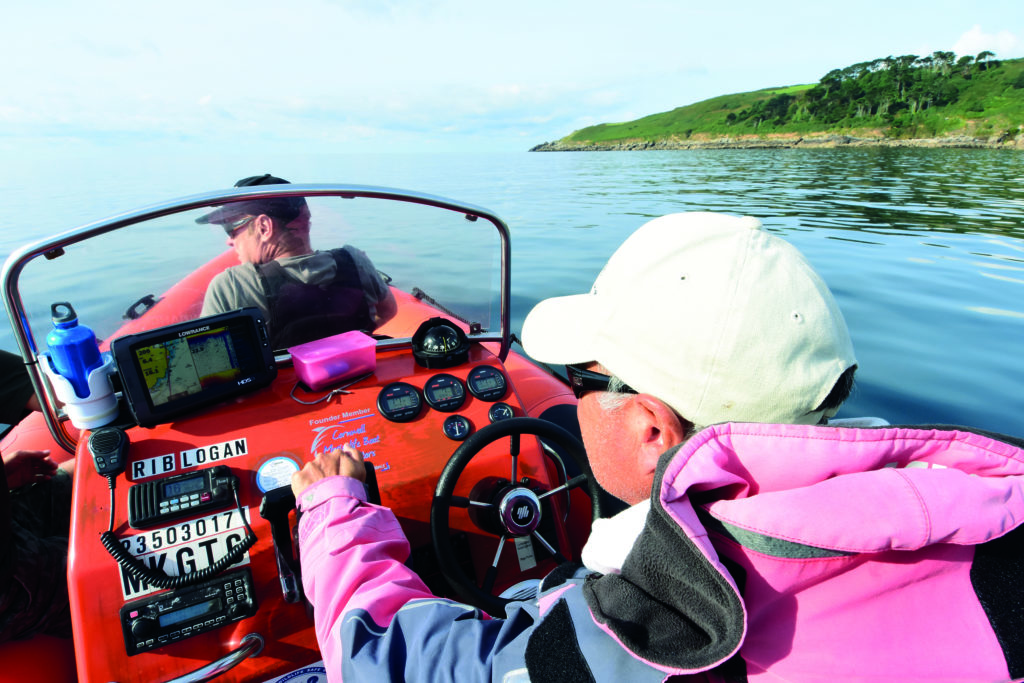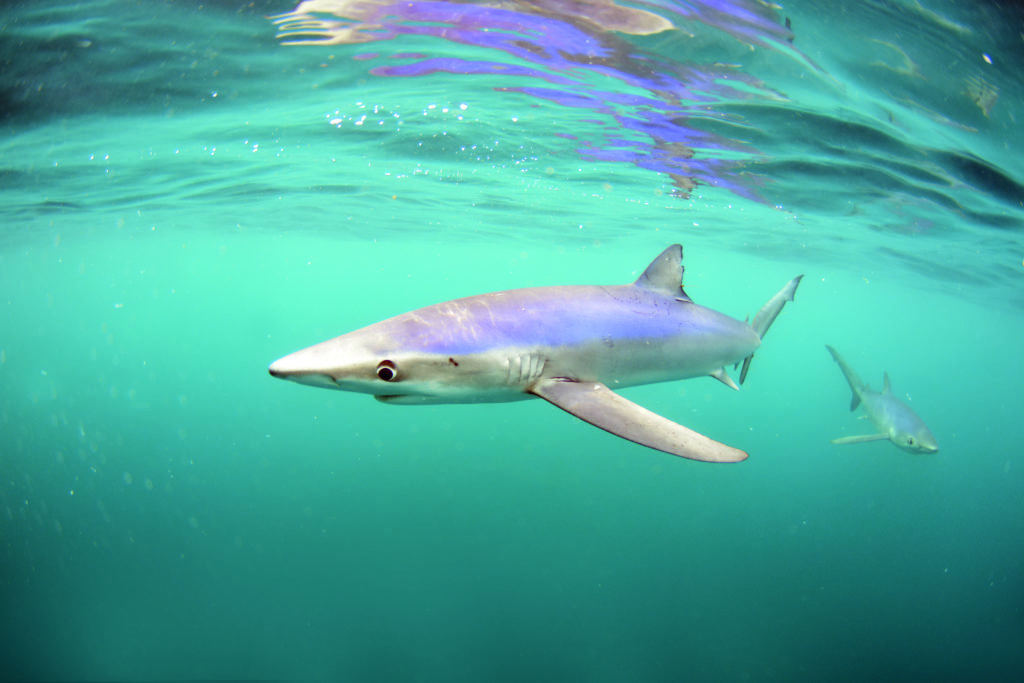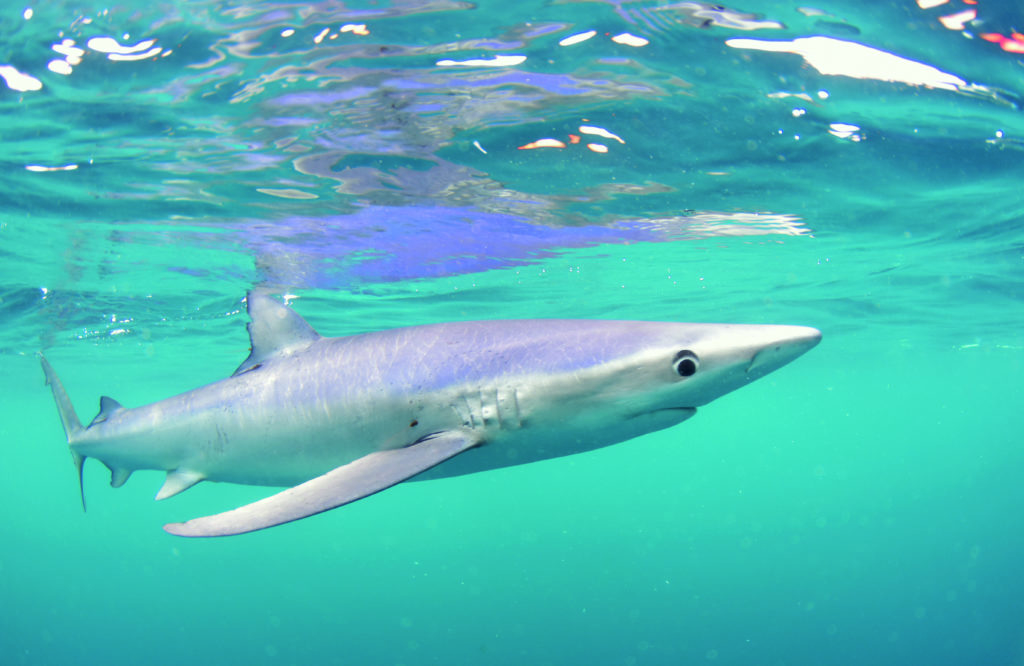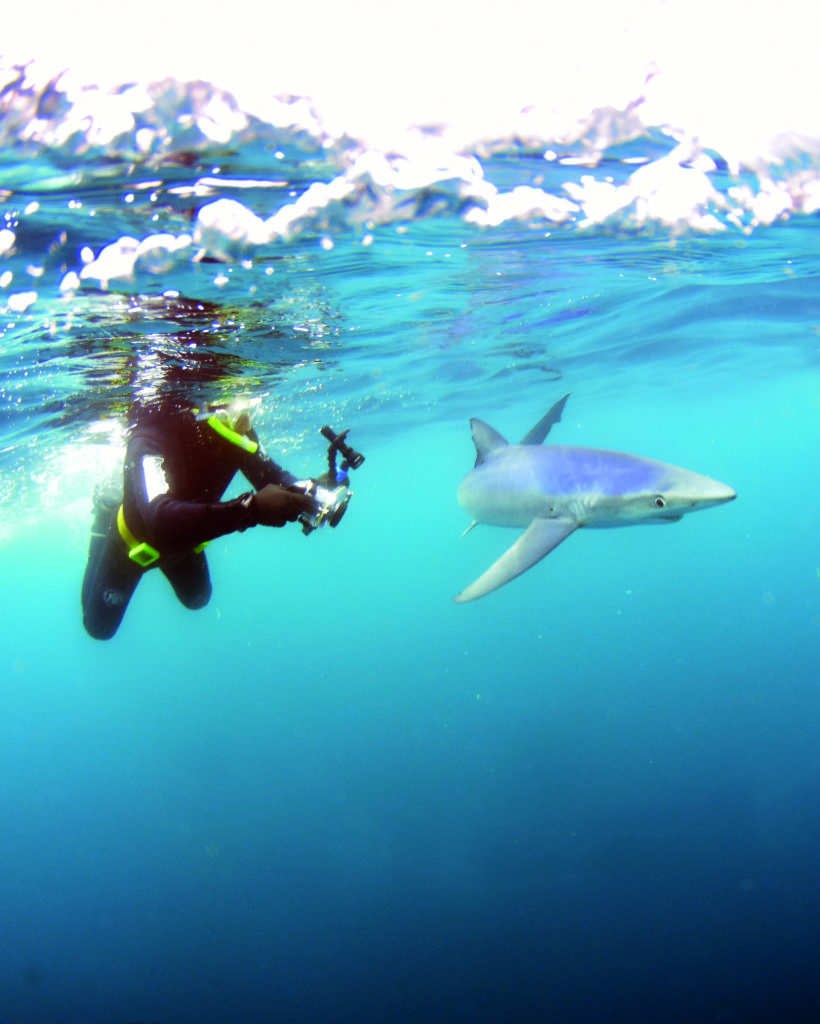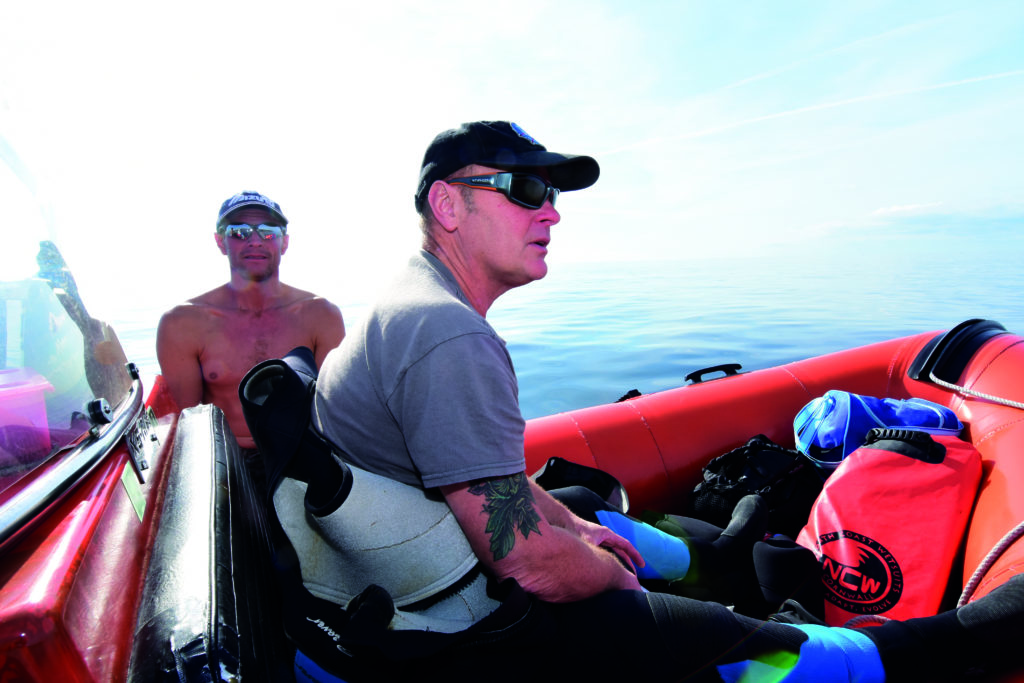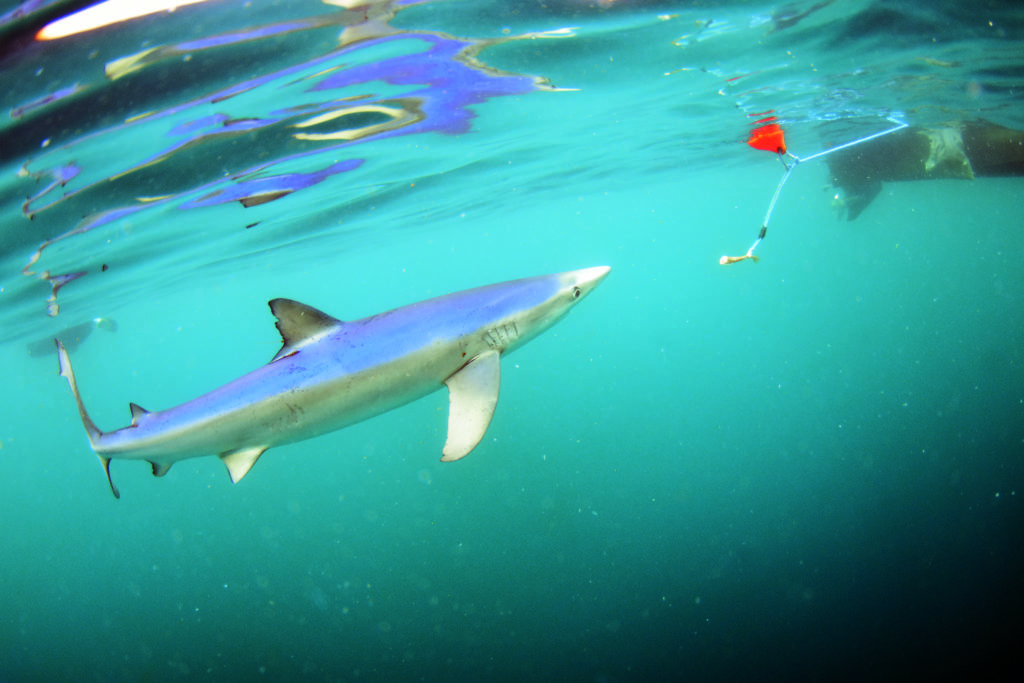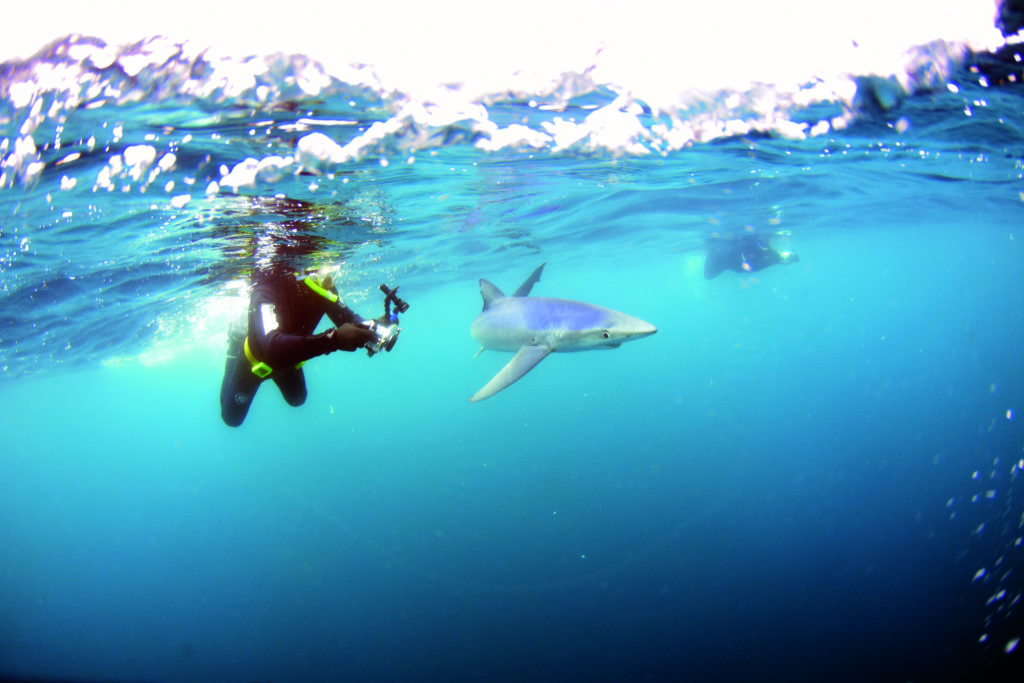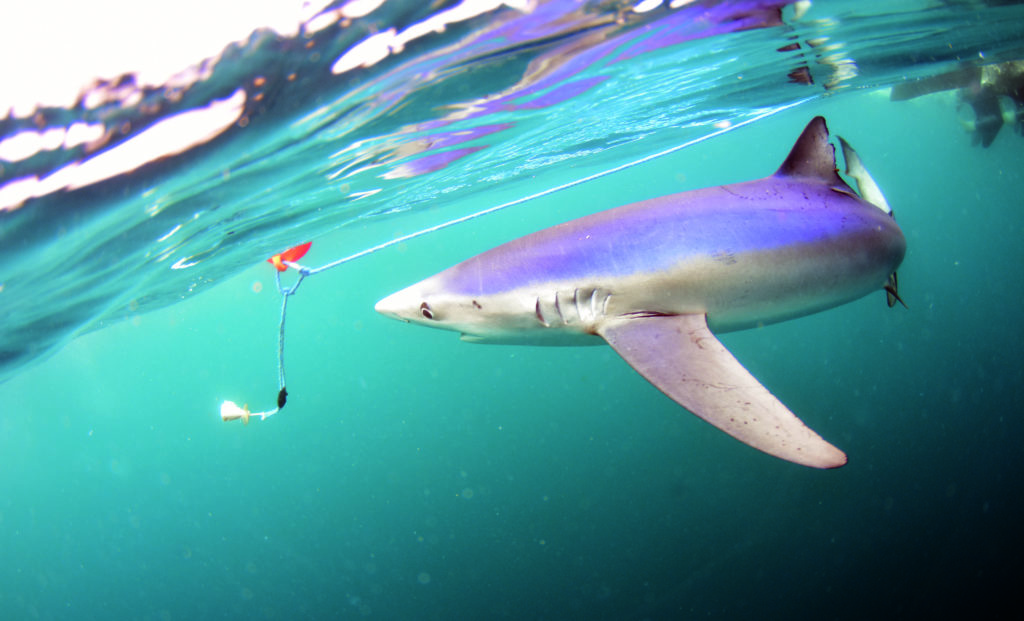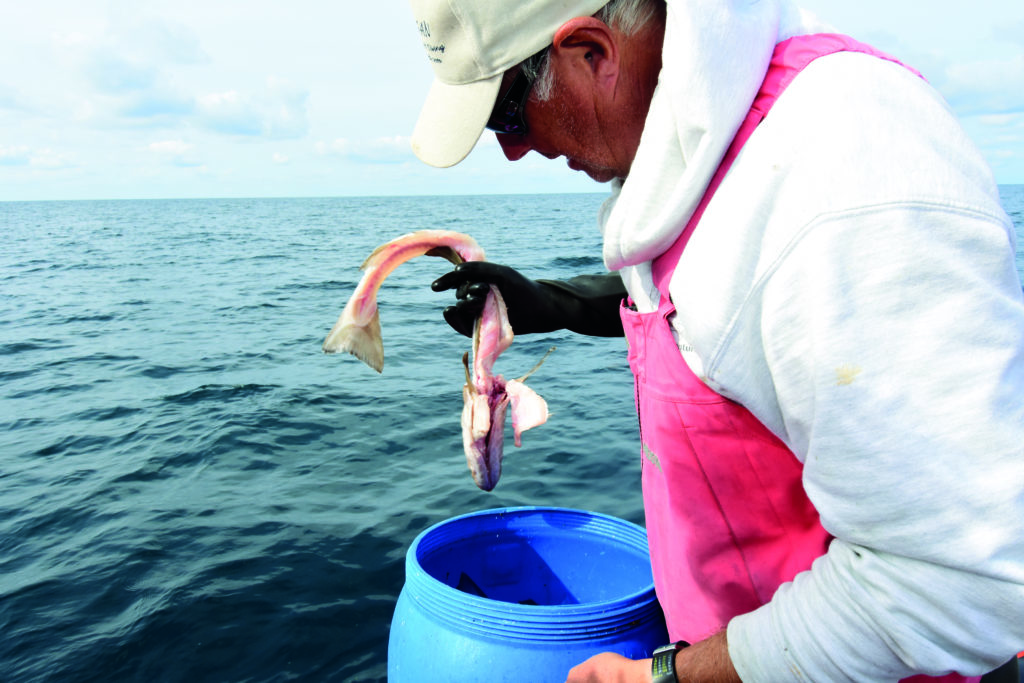JEREMY CUFF heads to offshore waters for a twist on the Above 18m series – because this is a ‘drift-snorkelling’ trip, it’s more a case of Above 18in!
Diving or snorkelling with sharks is normally thought of as something that goes on overseas, and it’s to some people’s surprise (and to tabloid journalists’ delight, whenever the story makes the wider media), that you can do the same in the UK.
I had been aware of the blue shark encounters off the coast of Cornwall for some time, and it was in December, while planning my New Year activities, that the Cornish blues again bubbled to the top of my to-do list. I had done two blue shark trips previously – but fancied doing it again.
Options for this type of trip are very limited because of the niche nature of the subject and the relatively small time window in which the sharks can reliably be seen, and the weather is potentially most stable.
I chose to go with shark enthusiast Charles Hood, who is friendly, knowledgeable and keen to share his interest in sharks. The trips run out of Penzance (weather permitting) between late June/early July and early October, and his success rate in finding the blues’ is around 95%.
The blue shark is a species of the open water and deep reefs, with a global distribution that covers tropical, sub-tropical and temperate zones. These sharks are known to cover great distances, and are thought to reach waters around the UK and Europe by using currents such as the Gulf Stream.
Very sleek, blues are clearly suited to their pelagic lifestyle. They are known to hunt small fish and cephalopods (especially squid), though they are also thought to feed on bottom-dwelling species on occasions.
Their coloration on the back and flanks, though always blue as their name suggests, can differ markedly between individuals, from a blue-tinged grey to a very deep blue, which contrasts with the white underside.
Blue sharks can attain an impressive 4m in length, although most specimens encountered will be significantly smaller. A record blue shark was caught by fishermen off Penzance in August 2017 – it was a massive 113kg specimen. Thankfully, it was returned to the water, but we didn’t manage to encounter it on our trip!
Arrival at the ’shark site’
The meet-up for the trip is around 8-8.30am in the main Penzance car park next to the harbour and slipway (where Charles launches his boat, RIB Logan). There’s plenty of space and I’ve never seen it full, especially first thing in the morning.
In terms of the shark site itself, Charles aims for a general area in which the sharks have been reliably encountered in the past through trial and error, rather than a specific seamount or pinnacle that approaches the surface. The area is about 15 miles offshore and 17 miles from our starting point.
Once the engine is switched off, Charles gets to work attracting the sharks as we drift with the current. Nothing is guaranteed in the ocean, and it’s certainly possible to spend all day in seemingly perfect conditions without any sightings whatsoever. While we waited, we wondered what would our encounters would be like.
It would be almost impossible to encounter blue sharks without having something to attract them in, so Charles uses pre-prepared chum, which creates a slick that leads to the boat. He deploys it as soon as we’ve arrived in his chosen area.
The chum is quite rancid, and won’t suit those of a squeamish disposition or anyone who gets badly seasick. Even while in the water, you’re very aware of it because you tend to spend most time in the “best area”, which is downcurrent of the chum basket. If you swallow any water, you can taste it!
As the chum spreads out to cover a wide area, there has to be some way of making the boat and the area immediately around it the focal point of the shark’s investigations, so that they can be easily seen.
Charles does this by supplementing the chum (which remains in the water all day in the basket) with some fresh mackerel that he catches en route, throwing in small pieces at regular intervals.
He also attaches larger pieces of bait to a rope suspended by a buoy, which is floated a few metres from the boat. Any shark that investigates it can usually be seen breaking the surface, which alerts everyone to its presence. Then, once the sharks have become more confident, Charles can slowly draw the bait towards the boat, hopefully bringing any interested shark with it and into clear view.
Dive (well, snorkel) briefing
Although it involves snorkelling it tends to be divers who do this trip. Non-divers can participate, though it’s important that they are fully prepared in terms of the gear required and comfortable with the likely conditions and circumstances in which they’ll find themselves.
Back in 2016, at the same time of year (early September) I did the blue shark trip with Charles and got horrendously seasick, even though I don’t normally suffer badly with it. I was so ill that I was in the water puking and retching while trying to photograph the sharks – it wasn’t good.
This time, I sought out some decent seasickness tablets and ensured that I took the required dosage before setting out. It seems that open-ocean swells have a distinctive kind of movement that can catch people out, so be prepared. You have nothing to lose and everything to gain by taking them. Happily, I was fine on the later trip.
Other essentials include staying warm, remaining hydrated and bringing the correct gear. It’s surprising how easy it is to get cold out at sea, however balmy it might be onshore – warm coats or hoodies (ideally waterproof) and hats are therefore essential.
Bring food and plenty of drink to keep yourself going, too. And don’t underestimate the conditions (which can, of course, change considerably throughout a day).
It’s up to the participants to bring everything they need, because Charles doesn’t have room to carry spares for those who forget anything important. The essentials checklist is mask, snorkel, wetsuit (5mm minimum), fins, boots, hood and gloves. The sharks can be attracted to bright and light-coloured objects.
Charles won’t allow anyone into the water without a hood and gloves as protection. A weightbelt is also preferable for balance and posture in the water, counteracting the buoyancy of the wetsuit.
The first sighting of the day isn’t a signal for everyone to jump straight into the water, hollering and thrashing around. Instead, Charles advocates a period of confidence-building, with the sharks encouraged to become more comfortable and bold around the boat. This is best achieved by the participants remaining on the boat and slowly kitting up, while he works the chum and bait.
The close encounters
No one day is the same on this trip, either in terms of the number of sharks seen, or the confidence (or lack of) exhibited by the sharks around the boat and snorkellers, which can affect the quality or duration of encounters.
As on my previous trip, we had to wait 1-2 hours before our first blue turned up – a small specimen in this instance. When its fin and tail broke the surface next to the bait, a wave of anticipation swept across the boat.
The sharks tend to be skittish and wary initially, so we waited until they became more accustomed to the boat and the bait. Then a larger pair arrived, resulting in the disappearance of the small specimens that had begun to gather confidence. It was as though the larger pair had driven them away.
It was time to get wet and see if they would stick around. I was the guinea pig and had a few close buzzes all to myself before the others got in. The sharks seemed not to like all of us in the water at once and gradually moved away, so we decided to get out for a while and watch from the boat. We then experienced a lull in the activity until early afternoon.
Just as we were beginning think that we’d had the best of the day, a larger specimen of around 2m turned up, confidently checking out the bait and chum-basket. This was our opportunity to get back in the water.
We then enjoyed a prolonged encounter with this large, bold specimen as it moved between us, around us and sometimes right towards us, even bumping us with its snout on a few occasions. I wouldn’t say it was intimidating, but you would certainly give it respect. Charles said it was unusually bold for a larger specimen, as they tend to be more circumspect.
During the day, we also noticed that the sharks had more than a passing interest in the boat’s propeller. Sharks see and perceive the world in a very different way to ourselves and might have found the electrical field of the metal almost as irresistible as the chum.
Although fewer sharks turned up on our day compared to a very active set of encounters from the previous day’s trip, we were lucky to get this late encounter – it made the day. On one special day, Charles reported that there had been an incredible 20 sharks around the boat!

As we headed back to Penzance amid gathering winds (that would cancel the following day’s trip), everyone was happy. I imagined what the headlines of some tabloid journalist reporting on our trip would be (Killer Sharks Sighted Just Off UK Shores… etc). The reality was that we enjoyed a rewarding experience, encountering a species that rarely comes into contact with humans.
That evening in the pub, there was a contented tiredness among our group, and I slept like a log that night. It was a good day.
Blue sharks in Cornwall
There are two options for blue shark encounters in the South-west, either with Charles Hood based out of Penzance, or Atlantic Diving based out of Newquay. The Charles Hood trip, as described in the feature, is very good and allows snorkelling with the sharks (maximum of five participants).
The Atlantic Diving trip is also good, but is a cage-dive trip, where participants take turns to enter a two-man cage to view the sharks. www.atlanticdiver.co.uk
What you need to know
Type of dive: Actually, it’s a snorkel. As you can cover a fair distance with the current during the day, you could call it a “drift snorkel”!
Depth: Probably around a mammoth 18in, unless you duck-dive. As you’re in full wetsuits, which are very buoyant, I didn’t see anybody attempt this. It’s a good idea to take a weight-belt to help counteract the buoyancy of the wetsuit, and to provide better stability and posture in the water.
Marine life / What to look out for: Blue sharks (hopefully several). It’s also possible that you could see dolphins (we did), porpoises, sunfish or even basking sharks. Charles said that on one trip, what he believed to be a porbeagle shark once investigated the chum, but came in and went very quickly. Don’t rely on such surprises, but you never know what might turn up. Expect a few jellyfish in the water as well. Topside, seals are possible, especially on the rocks close to the coastline. Twitchers can expect to see several seabird species, such as fulmars, shearwaters, guillemots, storm petrels and gannets.
Visibility: Out at sea, away from the influence of river run-off, the water tends to be clearer. It is, of course, infinitely variable, depending on wind direction, current, plankton and other factors, but can be 6-19m if you’re lucky.
Seabed: It’s down there somewhere, but you can’t see it!
Hazards: Sunburn, dehydration, cold and seasickness are the main hazards and not to be under-estimated. Take decent seasickness tablets, plenty of fluids and some warm (ideally waterproof) clothing. If you don’t, a day of misery could await you.
Photographs by Jeremy Cuff
Also on Divernet: Rhapsody in Blue, Freak Event: Snorkeller Plays Down Shark Bite, Divers Snapshot 2,000 Sharks & Rays
